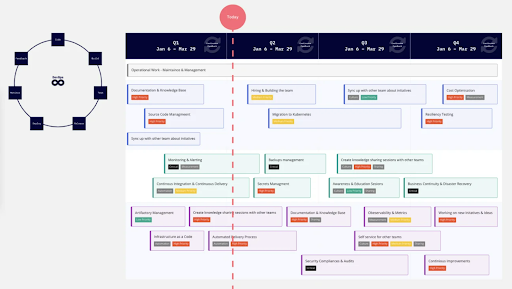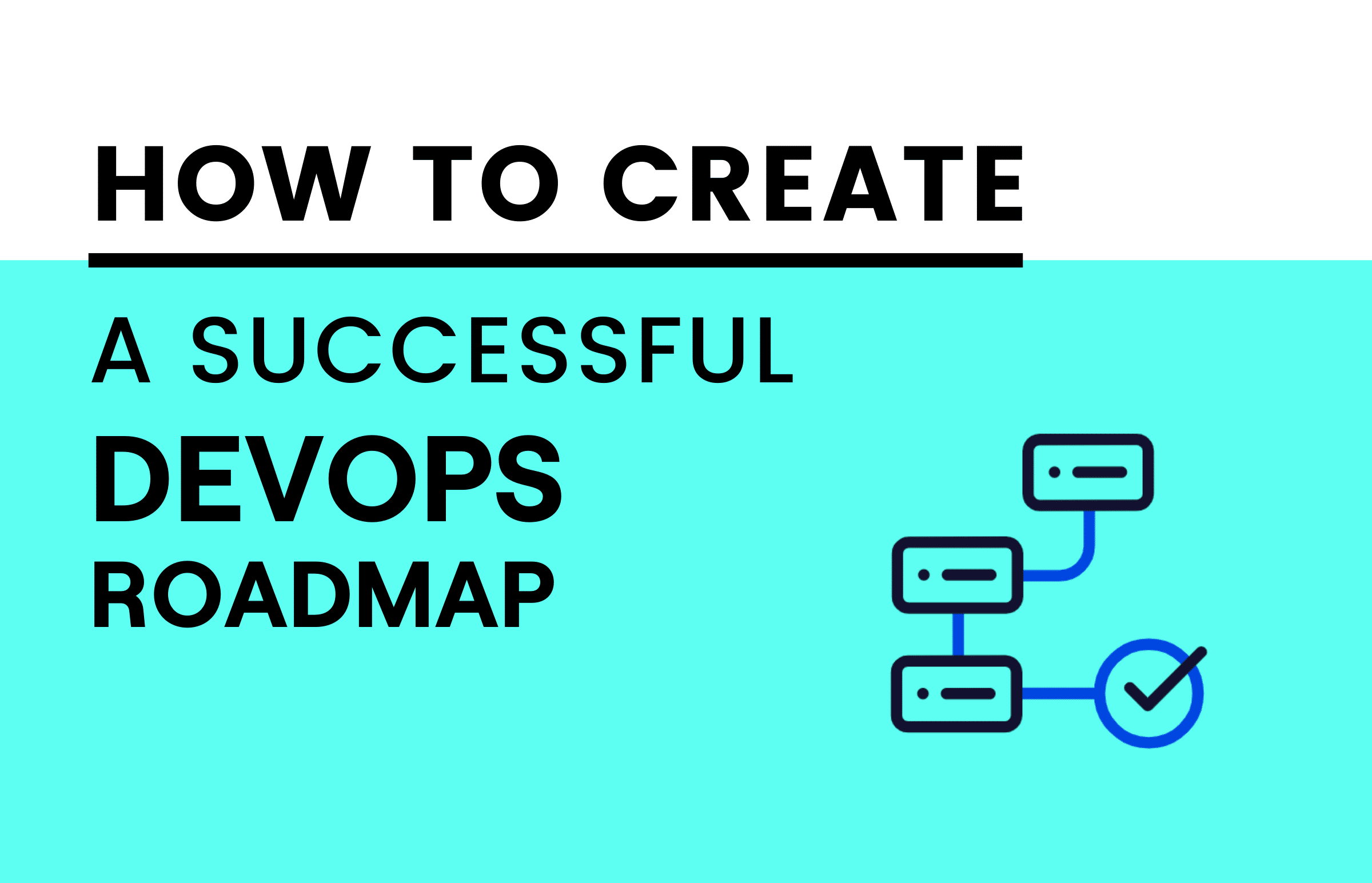Unlike the traditional linear — or waterfall — approach to software development, DevOps methodology brings together the engineering and operations teams and has them working closely together throughout the product release cycle.
The DevOps process relies heavily on a Continuous Integration/Continuous Delivery (CI/CD) pipeline. This is a set of practices where developers implement frequent code changes and use automated build-and-test pipelines to deliver the code in quick and reliable increments.
As a result, a DevOps team can achieve:
- A higher level of output
- Standardized production cycles
- More transparent and efficient development
- Improved cross-functional collaboration and understanding
It’s a complicated process, and a lot can go wrong. That’s why a DevOps roadmap is a must if you want your teams to take full advantage of DevOps architecture.
With that in mind, let’s take a deeper dive into why DevOps roadmaps are essential and how to create one.
What Is DevOps?
DevOps stands for “development and operations.” It’s a combination of coding philosophies, principles, practices, and tools that seek to eliminate the silos between operations and development teams when building software.
In the traditional waterfall approach to development, one team would complete all of its work before handing it off — or in some cases even showing it — to the other. This can result in delays, misunderstandings, and a lot of back-and-forth that can be avoided with timely communication. In contrast, DevOps professionals collaborate across the product lifecycle, from development and testing to deployment and on-going software iterations.
In the short time that DevOps has been around — the term was first coined in 2008 — it has revolutionized software development, and no wonder. Among other things, the DevOps model improves communication and encourages IT professionals to develop a broader range of skills. And by enabling continuous deployment, it also helps achieve a considerably faster time to market.
What Is a DevOps Roadmap?
Think of DevOps roadmaps as technology roadmaps designed specifically for DevOps projects. Like technology roadmaps, they are long-term planning tools that allow teams to strategize complex software development projects and define goals, tasks, timeframes, risk factors, and other essential elements of the DevOps journey.
Why Do You Need a DevOps Roadmap?
You’d be hard-pressed to design a DevOps strategy without a roadmap. When used right, roadmaps are highly effective tools that give your DevOps team a long-term perspective of their projects. At the same time, roadmaps enable teams to:
- Set clear priorities
- Break work down into smaller daily tasks and short-term milestones
- Collaborate smoothly
- Properly allocate and manage resources each quarter
- Avoid getting overwhelmed
In that sense, a DevOps roadmap is not too different from a standard technology roadmap. However, there are some benefits that are exclusive to DevOps roadmaps. Here are a few of them:
Faster Time to Market
Roadmaps help DevOps professionals keep track of their work and stay aligned on priorities, interdependencies, and deadlines. Each team can see what the other is working on, how they are progressing, and which upcoming items will need their attention in the next cycle. This enables them to organize their time better, collaborate more efficiently, and align the development process to business needs.
When you combine this with the heavy use of automation tools and continuous integration and delivery in DevOps projects, you can really accelerate a product’s time to market.
Frequent and Regular Software Releases
DevOps roadmaps help foster a highly collaborative work environment. Thanks to the constant collaboration and feedback from the operations team, engineers can iterate code in small increments. This agile approach allows for continuous delivery, frequent and regular software releases, and more streamlined development. As a result, companies can put out new products faster and with fewer setbacks along the way.
Shorter Development and Testing Cycles
The DevOps methodology is all about shorter development cycles, frequent code check-in, and continuous information-sharing. While this enables the DevOps team to monitor and guarantee software quality at every stage of the process, the intense focus on the short term can sometimes cause them to lose sight of the bigger picture. A DevOps strategy roadmap can make sure everyone stays on track.
Quick Error Detection and Recovery
The robust monitoring and automated, continuous testing that characterize the DevOps process make it possible to catch and address potential issues early on. Furthermore, automating software releases and deployments will strengthen the DevOps process by eliminating human error. A good roadmap can help improve this process even further by providing a timeframe, an automation strategy, well-defined tasks, and clear goals.
Increased Security and System Resilience
When you combine continuous monitoring, automated testing, incremental improvements, and constant feedback with a well-thought-out DevOps roadmap, you can set up a system that can not only put out a reliable product but is also secure, resilient, sustainable, and highly scalable.
How to Create a DevOps Roadmap
No two roadmaps are alike. Each one will differ based on the unique needs of your DevOps team and what they are currently working on.
However, that doesn’t mean you should start from scratch every time you embark on a new project. You can save a lot of time and effort by creating a standard DevOps roadmap template and then tweaking it as and when needed.
If you need some inspiration, here’s our tried-and-tested process for designing DevOps roadmaps. Feel free to use it as it is or change it to meet your needs.
Step #1: Define the Main Objective and Set Clear Short-Term Goals
We like to start by getting crystal clear on the main objective. You can have more than one, but more than three may be pushing it. Remember, each smaller goal, task, and milestone needs to further the main objective. If you have too many, you may not be able to create truly streamlined and results-driven workflows. There’s just going to be too much going on, resulting in noise and confusion.
Once you have your primary objective, create a step-by-step plan for achieving it. Break the work down into smaller increments and try to be as specific as possible. Before you add anything to the roadmap, make sure that it serves the main objective.
As for the timeframe, most DevOps roadmaps span a period of one quarter to a year. For best results, consider planning no longer than three months ahead. This way, you will be able to stay focused and plan long-term while retaining sufficient flexibility to change things as needed.
Step #2: Share the Draft Plan with Your DevOps Team
Show your plan to your DevOps team and ask for their input. Consider their suggestions and revise the roadmap if necessary. Keep in mind that the goal of a DevOps roadmap is to bridge the two departments and help them work together as smoothly as possible, so any feedback they may have is valuable and should be taken seriously.
You can also invite other team members, clients, or stakeholders to pitch in.
Step #3: Create Workflows and Encourage Collaboration
Next, create specific task flows and assign them to the appropriate team members. Schedule regular check-ins and create checklists to make sure nothing slips through the cracks.
Don’t forget to also provide your DevOps team with the tools they need to collaborate efficiently and effectively, such as visual cues that make the roadmap easier to navigate and understand. Opt for a simple color palette and label each action item with tags like “Low Priority,” “Medium Priority,” and “High Priority.”
Step #4: Automate, Automate, Automate
Your roadmap should allow for as much DevOps automation as possible. With such a high number of handovers and back-to-back processes, automation is key to success. The primary rationale of DevOps is to minimize the friction between development and operations, so automation must be inherent in your planning.
Step #5: Review and Update Your Roadmap Regularly
Your roadmap should not be set in stone. Keep it open to change and revise it as and when needed. Your priorities may change over time, and you should adjust your DevOps workflows accordingly. Schedule regular review sessions and make changes as the project evolves. You may even encourage your DevOps team and other stakeholders to review the roadmap on their own and suggest updates.
DevOps Roadmap Example
If you need visual inspiration for your roadmap, check out this template. It’s highly customizable and has handy features such as:
- A moveable “Today” placeholder to help track progress over time
- A circular workflow that includes both teams’ delivery pipelines plus a continuous feedback loop between your organization and your customers
- A roadmap outlining quarterly priorities for each product and project

Do You Need Help Designing Your DevOps Strategy?
You’ve come to the right place. Our in-house experts have extensive experience and in-depth knowledge of DevOps processes. Whether you need a complete roadmap for your entire strategy or multiple smaller product roadmaps, we can help you design the best solutions for your DevOps team.
For more information, read about our software consulting services or contact us directly.
Further Reading
Want to learn more about DevOps? Check these posts out:
- How to Simplify Your SDLC with Azure DevOps
- Reducing DevOps Costs with Serverless Architecture
- Why DevOps and SRE Are the Future of Software Development


